25th June 2025
This session had two tables playing very cultured games about classical music and art galleries while the third table tried to survive a zombie apocalypse.
Although lacking something of the style of a polished string quartet, Steph H, Darren C, Iain D and Steve L (collectively “the Tiny Violin Club”) assembled for the first proper performance of Luthier after last week’s rehearsal at the local pub. First violin Steph did her usual job of keeping the unruly in check (partially successful) while also giving clarity to the rules challenged members of the ensemble (some of whom might struggle to carry a tune in a sack on this evidence). Yes, it was hot last week, but we can all count up to three, can’t we?
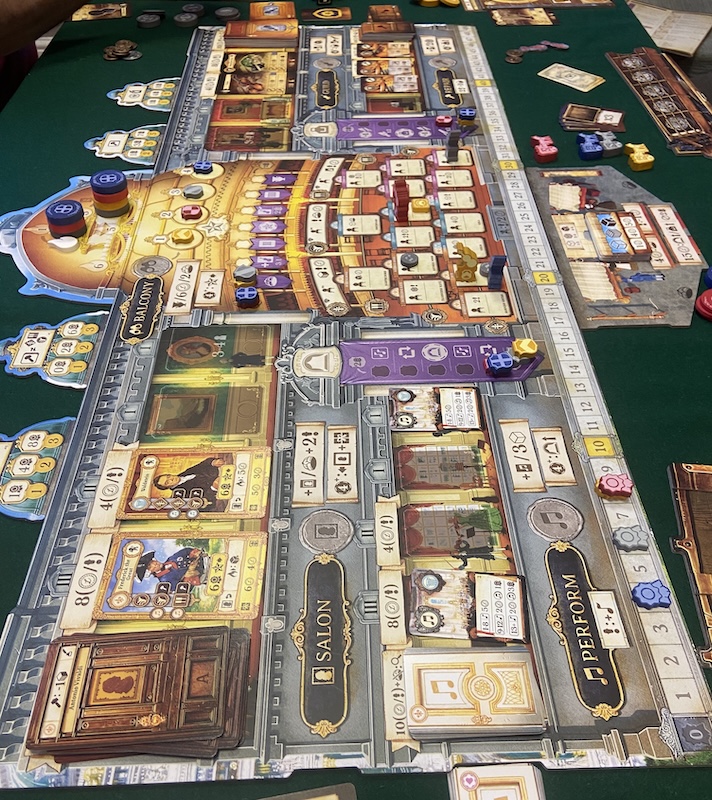
Luthier (pronounced Looty-er) sees players cast as manufacturers of orchestral instruments during the Baroque, Classical and Romantic musical periods from 1600 –1900. So, just for one night Iain and Darren became the heads of piano making dynasties (John Broadwood and Henry Steinweg respectively), Steph took on the guise of Italian string specialist Giovanni Guadagnini while Steve saw himself the master of the French harp and changed his name to Sebastien Erard (but was miffed not to have had an Italian option to choose from). The choices here determined player set up and turn order.
Players compete to gain illustrious patrons (famous composers, musicians, nobles and even royalty) who will fund them to make and repair fine instruments and hopefully then see their handiwork showcased in stunning performances (sometimes), or played by the maestros who lead sections of the orchestra (e.g. the aforementioned first violin). And for social climbers, there are also opportunities to rub shoulders with the smart set watching from the balcony, for the public acclaim and awards that can bring. Although patrons will dispense gifts, they can lose patience and take their patronage away if their priorities are not met.
The game uses worker placement mechanics with the power of an action and execution priority between players determined by a combination of worker strength (from 1-5, hidden from opponents) and the order in which competing tokens were placed. Contract fulfilment bonuses can be earned from meeting a patron’s specific requirements and there is also an element of area control from occupying first chair seats in the orchestra. How these high-level aims are met differs between action spaces. For example, the success or otherwise of a performance includes a roll of custom dice, while manufacture doesn’t have a random component but is a two-stage process (roughing out the basic shape, then polishing and adding fine details) requiring two separate actions. Of course, the luthier’s work also needs resources and wood, brass and animal by-products (such as hair and skin) must be purchased from a market with prices fluctuating between rounds. Naturally, a grand piano requires more wood than a lute (yes, that is a lute, or are you calling me a lyre? Thanks, Iain for that) and woe betide the luthier who has miscalculated his resource needs (which may explain why Iain spent so long roughing his oboe). On the other hand, the larger instruments generally bring more prestige points, and it is these which will ultimately determine whether your work will be sought after by collectors willing to pay six figure prices hundreds of years later or can be picked up in a pawn shop for a fiver.
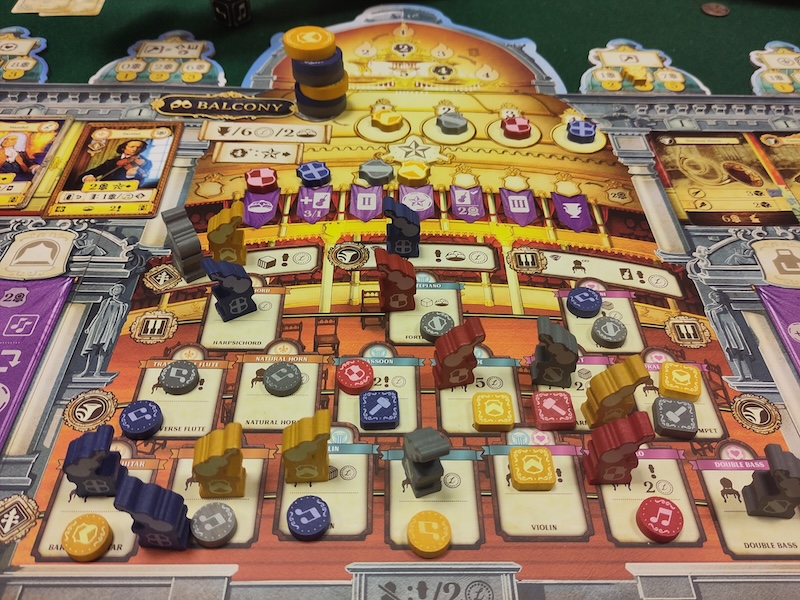
And so to the play, which commenced with a now traditional 3-1-2 countdown and a helpful suggestion that Steph might like to head straight to the market, whatever the rules say about turn sequence. The rush was then on to complete the first patrons as soon as possible (earning recurring bonuses), while positioning for what comes next by securing new patronage and instruments matching the patrons’ requirements. Steve and Steph set the early pace with Darren following a few points behind, while Iain was slow off the mark as he divided his time between reading the rules and contemplating his oboe. However, by mid game Darren had caught up as the lead changed hands several times and it looked likely to be a race between this trio for first place.
Entering the final round, Iain seemed destined to become a pawn star, but somehow pulled off an impressive comeback to remind the others that they had started the night as a quartet and should bally well finish it that way too. By roughing and completing two instruments, bumping Steve off two first chairs in the process, he was suddenly neck and neck with Darren and Steph, although Steve was able to take a narrow lead thanks to completing a rare hurdy gurdy much to Frederick the Great’s satisfaction. Yes, really. Tense final scoring saw Steve retain his lead (helped by a passing Jeremy J, who had never seen the game before but still noticed that Steve had underscored his personal objective) with Steph, Darren and Iain tied for second place a few points back. As close a game as all could remember and hopefully the band will stay together for another performance later in the year.
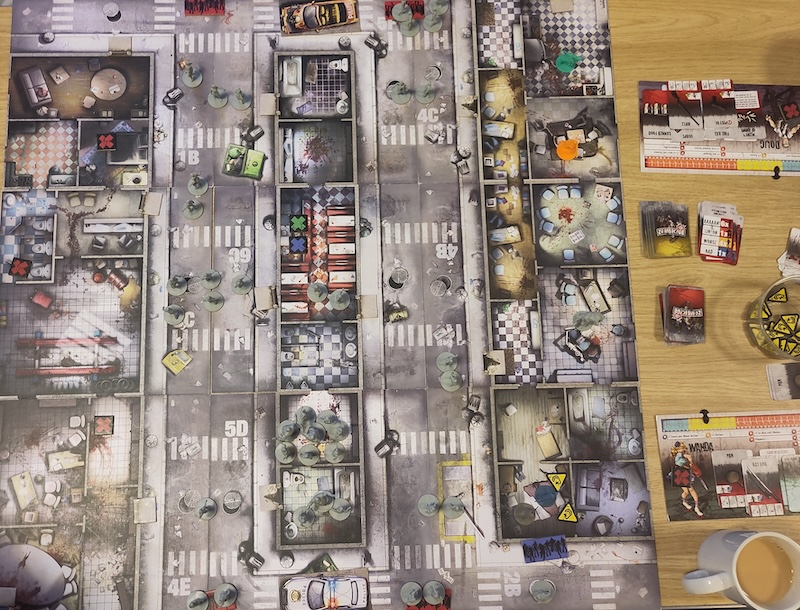
Neil O. also got started early setting up a Zombicide scenario. This time it was a new scenario from a downloadable expansion that involved a secret tunnel connecting two big buildings. The mission was fairly simple, collect the eight objective markers spread across the three big buildings. The problem being the survivors started in one corner and could only access two buildings initially and either needed to plough through the middle building on foot and get to the third one across the street or try the secret tunnel to sneak into it. Things started pretty well, a successful entry to building one and spawn all the zombies within with no one even getting scratched. Then whittling down the initial zombies with all the survivors doing their share and levelling up in the same round.
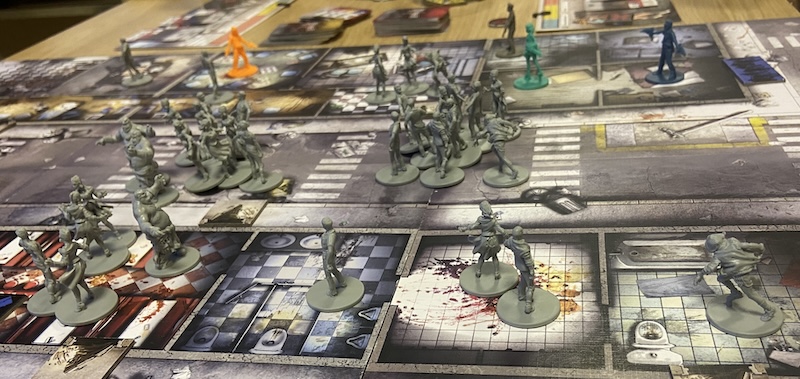
Then the problems started with the new higher zombie spawn numbers an abomination appeared and that can only be killed with a molotov cocktail, which meant finding the bottle and petrol to make one. So the next few rounds involved running around the building trying to stay ahead of the abomination and do some searching. The bottle appeared straight away but the petrol was more elusive and when it was located it was by the survivors at one end of the building whilst the other two with the bottle and the abomination had got stuck at the other end playing pass the chainsaw and thinning out the hordes of zombies coming in off the street. The abomination was then roasted but now a new difficulty level of zombie spawns had been triggered. This led to an unfortunate draw of runners having two turns and catching Neil’s survivor and chomping on him before anyone could help. Then we decided Dan’s survivor might as well finally open the secret passage and reveal the final building. We had defeated enough of the initial zombie waves that there were sufficient zombie models left in the box to spawn but some more double move spawn draws very quickly finished off the final three survivors and it was a win for the Zombies and only three objectives collected by the (not) survivors. Always a challenging game, we got a bit bogged down in the first building with the abomination and the zombie spawns just kept stacking up, but the two new players enjoyed themselves and said they would try again at a future session.
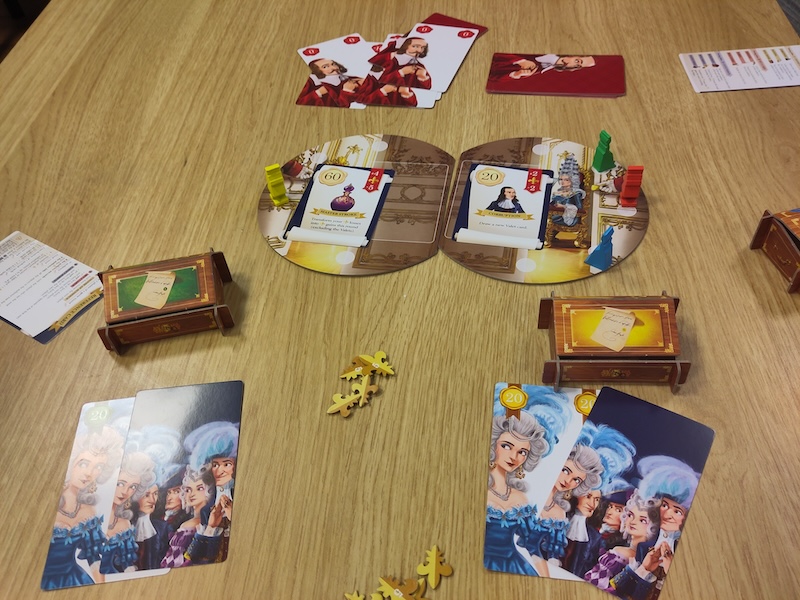
The remaining 3 players started with a shorter game and were joined by 1 latecomer whilst setting up Royal Secrets. This is similar to High Society where you have a limited hand of bidding cards, but instead of status you trying to gain favour (which changes each round) with the King or the Queen - but whichever you choose you will be helped or hindered by others vying for the same favour. The interesting mechanic is that after your turn you get to choose who will be next, so you can try and force others to reveal their next play. Each player (aristocrat) gets two bids, one at a time, one will be played face up and the other down, so there can be some bluffing and double bluffing. The bid cards played from all players seeking the same royal’s favour must meet or exceed this rounds favour requirements, if they do they all get victory points and the aristocrat who bid the most gets the favour - which is a special one time card to help in future rounds.
This was the first time out for Dave’s game, and there was an element of learning and gentle bluffing, with Dave, Richie, Jeremy and Graham dipping their toes into court intrigue. It was going reasonably well when Dave used a favour to switch us on to the King’s favour so he would get the ear of the Queen, unfortunately all three of us failed to meet the King’s price and were hit by a negative score, which meant that at the end of the game Dave was the best at court (31 points), Jeremy (28) and Richie (26) were close behind, with poor Graham being picked on by us and ending up with 2 points (when we all started on 10 points!!). It was an interesting twist on bidding and bluffing and would be interesting to play with 5.
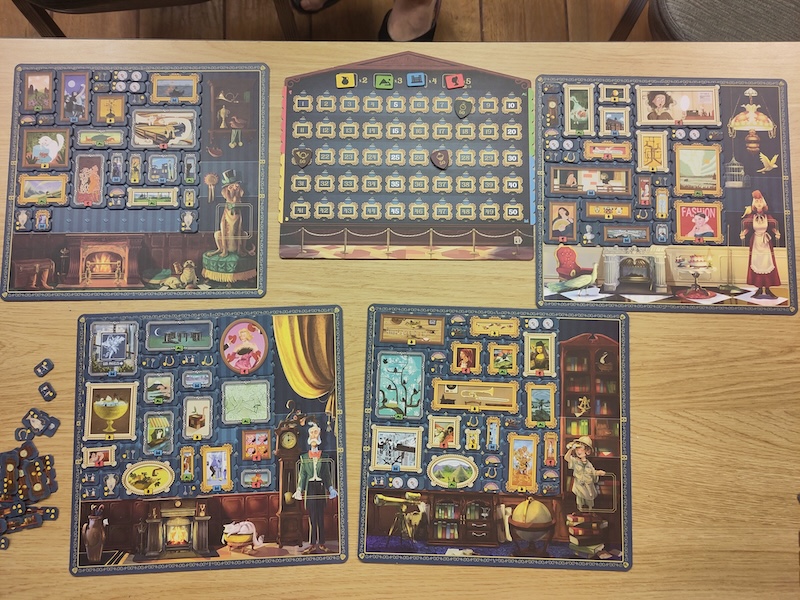
Then the aristocratic gamers turned into four budding collectors for a game of Art Society which was last played in session 76 where you can find a better explanation of the rules. The short summary is that each turn, 5 pictures are chosen for auction, the player who bids the highest gets first choice on the paintings to put in their gallery. The last painting left increases the rating of the type of painting it is - portrait, landscape, object or place - which will make it worth more at the end of the game depending on its final rating.
This time saw two previous collectors (Richie and Jeremy) bidding against two new collectors Graham and Dave. It didn’t take long for them to get into the swing of hanging pictures and getting frame bonuses to land some extra decor to fill in those pesky gaps on the wall. There were some interesting rounds where only one of us was really interested in the paintings, and others where we were all bidding the same high values - meaning the previous round’s bid value became your bid (to resolve the ties) - which costed Graham for several rounds in succession. In the end it came down to Richie finishing off his wall and ending the game, but Jeremy managed to also complete his wall in the same turn.
The scores only get totted up at the end based on the best pictures you have in the eye line and then a total of the scoring for other paintings (based on their rarity) and your decor bonuses. Though Graham and Dave made a valiant effort to create a picturesque wall, Richie and Jeremy ended up on the same points in the lead, with a tie breaker of how many bidding points were left, so Jeremy just took the final prize.
Finally while the orchestras were still playing on the other side of the room, those that could stay later merged groups for a quick game of club favourite Braggart (now 16 club plays) for some tall tales of epic or not so epic adventures.
The next session is the 9th July. Please come along and join us for more diverse games to suit most tastes. If you also join us on Discord then you can request games in advance or see what others are suggesting and reserve a seat.
- Total Session Attendance: 12
-
Board Games: